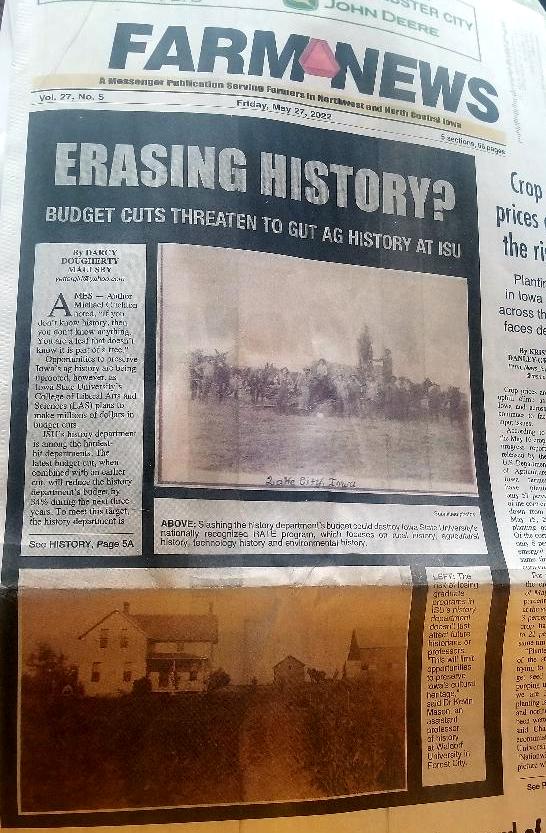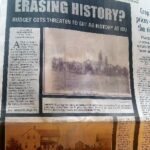
Whats HOT
Latest Posts
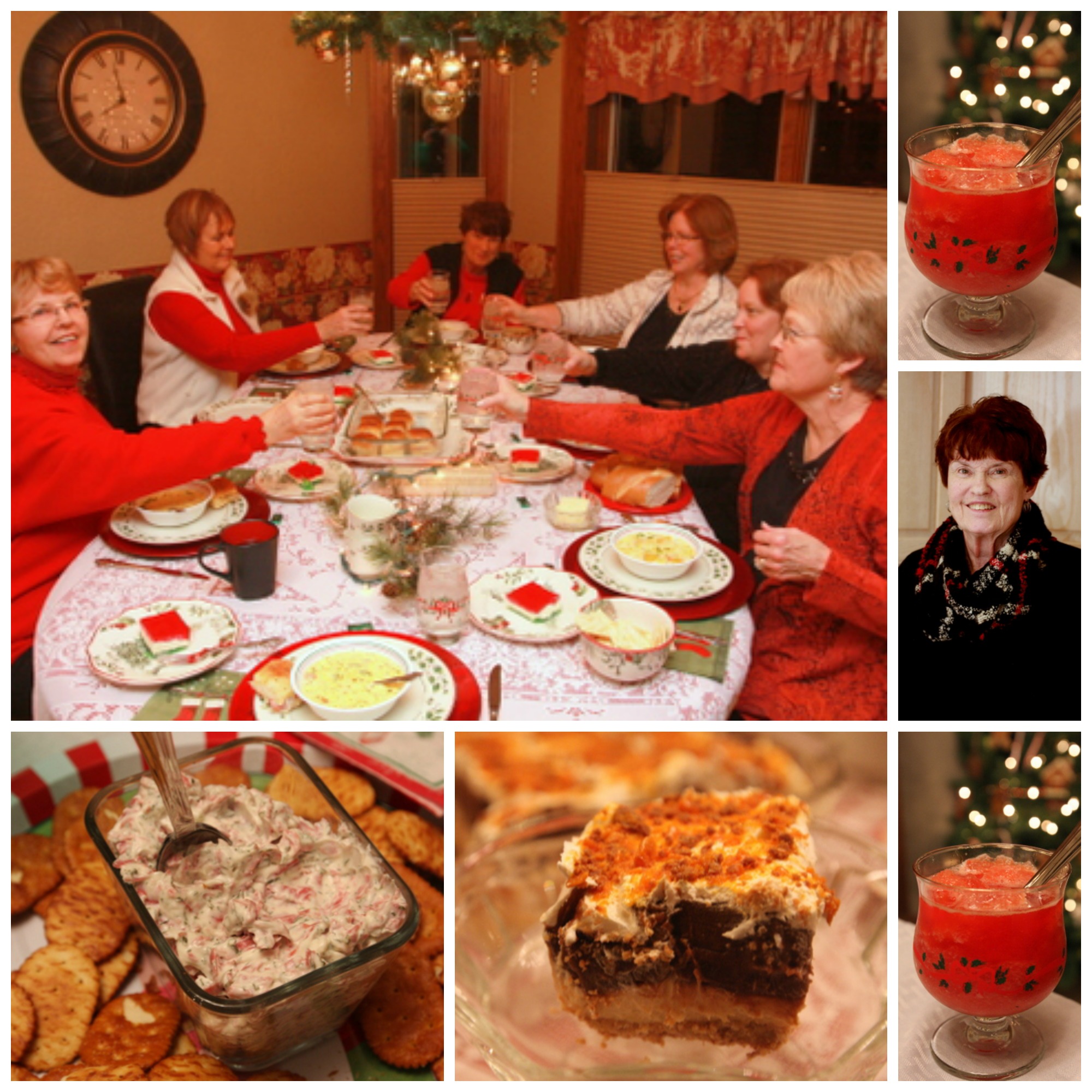
Shakespeare Club Maintains 123 Years of Good Taste in Small-Town Iowa
While one of Lake City’s oldest clubs likely wouldn’t have had any farm women for members when the group formed the 1890s, a farm wife (who is also my mom) is now the club’s president and has belonged to the group longer than any other member.

Jan Dougherty, Shakespeare Club president
“This was originally a very formal club where the ladies in town served white-tablecloth-style dinners and used their good china and silverware,” said Jan Dougherty of Lake City, president, who joined the Shakespeare Club in 1972. “Now we’re much more relaxed and just like to have fun.”
Part of the fun involves cooking classes, preparing homemade treats for the “lunch” following the meeting and sharing recipes. The group has visited Sweet Things Bakery in Lake City and recently enjoyed a cooking class taught by Robin Qualy of Lake City, who runs La Casa Cuisine and teaches people how to make homemade pasta and more.
“I like the camaraderie and enjoy getting to know people better through Shakespeare Club,” said Pam Feld of Lake City, who joined the group a few years ago.
Organized in 1894, the Shakespeare Club holds the honor of being the second oldest club in Lake City. It was organized by four young women interested in their social and intellectual advancement. Programs were arranged to study the lives and works of famous authors, although the greater part of each year was devoted to the works of Shakespeare. Later, the programs were diversified to include the study of music and the arts, as well as the cultures of Europe and South America.
During World War 1, Shakespeare Club members held benefit teas and auctions to raise money for the Red Cross. In the 1920s, a three-day celebration was held to commemorate the club’s silver anniversary. Parties, picnics, and a presentation of a picture to the library were part of the festivities. “The Shakespeare Club is famous for doing things right,” quoted the Lake City Graphic newspaper in 1923.
Through the years, club members have been instrumental in supporting the progress of schools and the local library, as well as civic improvements. As it has for years, the group continues to meet in members’ homes, and each meeting includes a program or special activity and ends with a luncheon.
“I like meeting in people’s homes,” said Pat Albright of Lake City. “It’s a comfortable feeling where we can be ourselves and enjoy each other’s company.”
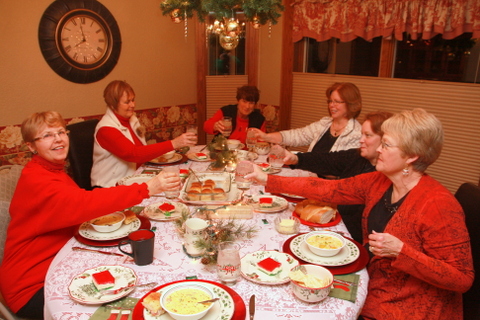
Members of Lake City’s Shakespeare Club enjoy homemade food and lots of laughs during this holiday celebration at Jan McClue’s home.
This also appeals to Jan McClue, who hosted the group’s 2016 Christmas party at her home near Lanesboro. “I like that we’re a group for fun, and I enjoy the interesting outings we go on around the area.”
One of the group’s favorite destinations is Studio Fusion in Fort Dodge, where members design their own glass picture frames, dishes, jewelry and more. No matter where they meet, however, snacks and homemade treats are always on the agenda. “Good food has always been part of Shakespeare Club, and I think it’s neat the club has lasted all these years,” Dougherty said. “Our motto could be, ‘We don’t meet if we don’t eat.’”

Darcy’s Corn Tortellini
Healthy Tortellini Corn Chowder
Smoky bacon combines with tender cheese tortellini for a creamy and comforting take on the usual corn chowder, which is one of my favorite soup recipes. I served it at the Shakespeare Club’s 2016 Christmas party at Jan McClue’s home near Lanesboro.
5 slices bacon
1 large onion, chopped
2 ribs celery, chopped
1 cup red, orange, yellow peppers, diced
2 cups fresh, canned or frozen corn kernels (about one and a half cans of canned corn)
2 cups chicken broth
1 cup sliced carrots
⅓ c unbleached or all-purpose flour or Wondra flour
3 cups 1% milk
⅓ cup chopped fresh basil, or 1 teaspoon dried basil
½ teaspoon salt
¼ teaspoon fresh ground pepper
8 ounces low-fat fresh or frozen cheese tortellini, cooked and drained
1 cup frozen green beans
1 to 2 cups diced ham, optional
Set a Dutch oven over medium heat. Add the bacon. Cook for 1 minute, or until it releases some of its moisture. Add the onion, celery, and bell peppers. Cook for 5 minutes, or until the vegetables are soft. Add the corn, broth and carrots. Bring to a boil over high heat. Reduce the heat to medium. Simmer for 15 minutes.
Place the flour in a medium bowl. Gradually add the milk, whisking until smooth. Pour mixture into the Dutch oven. Stir until well-blended. Add the basil, salt and pepper. Cook, stirring occasionally, for 3 minutes, or until the soup thickens. Add the tortellini, green beans and ham, if desired. Cook for 2 minutes, or until heated through.
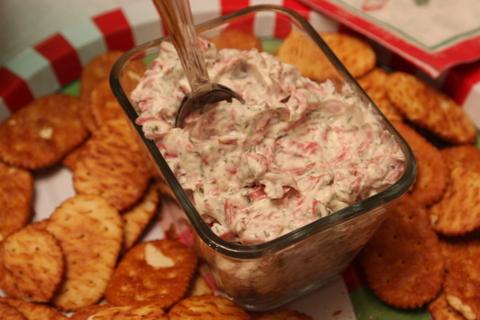
Jan McClue’s Beef Dill Dip
Beef Dill Dip
This tasty dip from Jan McClue is simple to make and can be served with bagel wedges or crackers.
1 16-ounce carton sour cream
2 tablespoons parsley
2 teaspoons Accent seasoning
2 packages dried beef, chopped
1 1 / 2 cup Miracle Whip
2 teaspoons dill weed
1 medium onion, finely chopped
Mix all ingredients together. Serve with crackers or bagel wedges.
Cheesy Artichoke Dip
This three-ingredient appetizer from Jan Dougherty of Lake City takes only minutes to make.
1 package cream cheese
1 can artichoke hearts, drained
2 cups shredded mozzarella cheese
Combine all ingredients. Bake at 350 degrees, or until top of the dip lightly browns.

Celebration Slush is oh-so-tasty!
Celebration Slush
This simple slush from Jan McClue, a Shakespeare Club member who lives on a farm near Lanesboro, makes any party more festive.
12 ounces frozen lemonade
12 ounces frozen limeade
1 1 /2 quarts cranberry-apple juice
1 / 2 cup granulated sugar
2 cups strawberry schnapps
2 cups water
Combine all ingredients and freeze in a plastic container, like an ice cream bucket. To serve, add a splash of lemon-lime soda pop, raspberry vodka or strawberry daiquiri.
Taco Soup
This flavorful soup from Marie Schwarm of Lake City is sure to please on a cold winter day.
1 pound of ground beef (cooked and drained)
1 can of corn 1 can great northern beans
1 can black beans
1 can red beans
1 medium size can of diced tomatoes
1 packet of Hidden Valley dressing mix
1 packet of taco seasoning
1 cup of water
Tortilla chips
Sour cream
Shredded cheese
Combine all ingredients in crockpot (do not drain the beans) except tortilla chips, sour cream and cheese. Cook on low for 6 to 8 hours. Serve with chips, sour cream and cheese. To spice up the soup, add a small can of diced green peppers.
Chili Bean Salad
This fresh, healthy recipe comes from Sharon Richardson of Lake City.
1 15-ounce can chili beans, heated Chopped tomatoes
Fresh spinach or lettuce, chopped
Corn chips
Make a bed of fresh spinach or chopped lettuce on plate. Top with chopped tomatoes and chili beans that have been heated. Top with crushed corn chips.

This luscious, rich dessert is a sweet symphony of creamy goodness.
Peanut Butter Dessert
This creamy, sweet Peanut Butter Dessert from Shakespeare Club member Pam Feld of Lake City offers an enticing ending for any meal.
For the crust:
1 cup finely-chopped cashews
1 cup all-purpose flour
1 / 2 cup butter
Cream cashews, flour and butter together. Press mixture into baking pan. Bake at 350 degrees for 25 to 28 minutes.
First layer of filling:
8 ounces cream cheese
1 / 3 cup creamy peanut butter
1 cup powdered sugar
1 cup whipped cream topping
Combine cream cheese, peanut butter, powdered sugar and whipped cream topping. Spread over cooled crust.
Second layer of filling:
2 2 / 3 cups milk
1 package chocolate instant pudding
1 package vanilla instant pudding
Combine milk and the two pudding mixes. Chill in refrigerator. When set, layer mixture on top of peanut butter layer.
Top dessert with whipped cream topping and pieces of chopped candy bars. Butterfinger and Heath work well.
Savor more Iowa food history
Want more great recipes and Iowa food stories? Check out my top-selling “Culinary History of Iowa” book from The History Press, and order your signed copy today.
P.S. Thanks for joining me. I’m glad you’re here.
@Copyright 2017 Darcy Maulsby & Co.
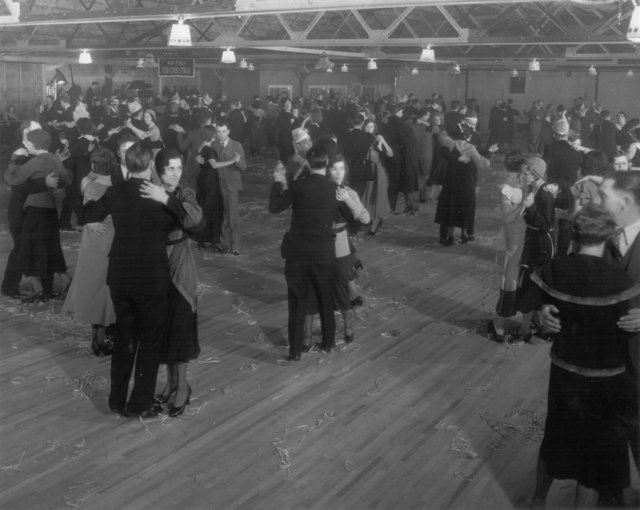
Celebrating New Year’s Eve in Style at a Classic Iowa Ballroom
There was a time when THE hottest place to be for New Year’s Eve was at one of Iowa’s ballrooms, which could be found across the state in cities, small towns and even in the country. While most of these iconic places are gone, Lake Robbins south of Woodward carries on a proud Dallas County tradition since 1931.
Here’s a glimpse of what makes Lake Robbins such a remarkable piece of Iowa history (photos courtesy Lake Robbins Ballroom):
Ringing in the New Year. The legendary Lake Robbins Ballroom opened Nov. 11, 1931, and soon became one of the hottest entertainment venues in Dallas County. With its 10,000-square-foot white oak dance floor (which is still in place), spacious interior and music from popular dance bands of the day, the ballroom became a destination. The photo at the top of this blog post which shows people dancing was likely taken on New Year’s Eve, circa 1933. Notice what appears to be confetti on the dance floor.
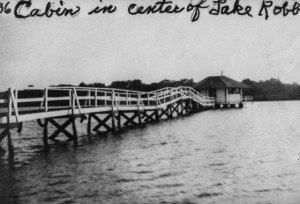
The beginnings of Lake Robbins. Located southwest of Woodward, Lake Robbins started as a natural pond. In the 1920s, Riley Robbins and his son, Mervin, built a man-made lake dredged out by teams of horses. Robbins built an eight-sided cabin with a boardwalk to the edge of the area that would become the famous Lake Robbins Ballroom. A drought in 1936 decimated the lake, which was not rebuilt.
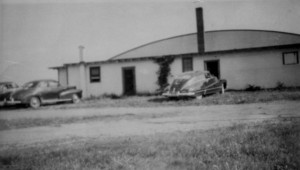
One of Iowa’s last ballrooms. Lake Robbins has always been in the country, and there’s only one way to get there—an unpaved country road. While the ballroom has always had a simple exterior, the magic occurs inside. Through the years, countless married couples first met at Lake Robbins. While many Iowa towns used to have ballrooms, Lake Robbins is one of the few that remains.
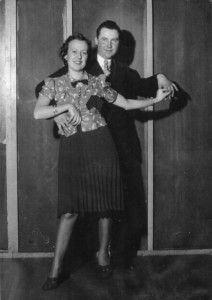
Soon-to-be-married dance champions. While they were not yet married when this photo was taken in 1938, Jacob Cushing of Adel and his future bride, Florence, won a dance contest at Lake Robbins Ballroom. The event was sponsored by Chaplin Gas & Oil. This photo was taken by Edmondson Studio in Perry.

Celebrating the good times. Young people from Dallas County and beyond flocked to Lake Robbins Ballroom, which was one of the few places in the country that had electricity in the early 1930s. Some say future president Ronald “Dutch” Reagan patronized the ballroom when he was a broadcaster at WHO Radio in Des Moines. Lake Robbins was inducted into the Iowa Rock & Roll Music Association in 2007.
 Let’s have a party! While some Lake Robbins performers slipped into obscurity, others became stars. Herbie Kay’s orchestra from Chicago that played opening night in 1931 featured 17-year-old vocalist Dorothy Lamour. In 1936, Lamour moved to Hollywood and made a series of successful comedies starring Bing Crosby and Bob Hope. Another Lake Robbins singer, Perry Como, had huge hits in the 1950s with “Magic Moments” and “Catch a Falling Star.”
Let’s have a party! While some Lake Robbins performers slipped into obscurity, others became stars. Herbie Kay’s orchestra from Chicago that played opening night in 1931 featured 17-year-old vocalist Dorothy Lamour. In 1936, Lamour moved to Hollywood and made a series of successful comedies starring Bing Crosby and Bob Hope. Another Lake Robbins singer, Perry Como, had huge hits in the 1950s with “Magic Moments” and “Catch a Falling Star.”
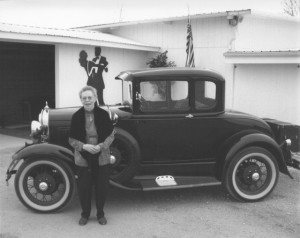
Kip Shannon’s 80+-year career. While she didn’t work on the opening night (Nov. 11, 1931), 23-year-old Coloma “Kip” Shannon stopped by the new Lake Robbins Balloom with her family. She got a job selling tickets there soon after and also handled practically every job at the ballroom during her career, which spanned nearly 80 years at Lake Robbins. Kip died at age 105 in 2014.
Today, owner Lyn Wilkinson carries on the Lake Robbins Ballroom Iowa legacy, caring for the beloved ballroom that she has owned since 1993. Stop by this remarkable venue for an evening of music, dancing and an unforgettable piece of Iowa history.
Want more Iowa culture and history? Lake Robbins Ballroom will be featured in my upcoming book, Dallas County, a pictorial history from Arcadia Publishing, which will be released in the summer of 2017. In the meantime, check out my top-selling “Calhoun County” book, which showcases the history of small-town and rural Iowa, as well as my “Culinary History of Iowa” book from The History Press. Order your signed copy today!
P.S. Thanks for joining me. I’m glad you’re here.
@Copyright 2017 Darcy Maulsby & Co.
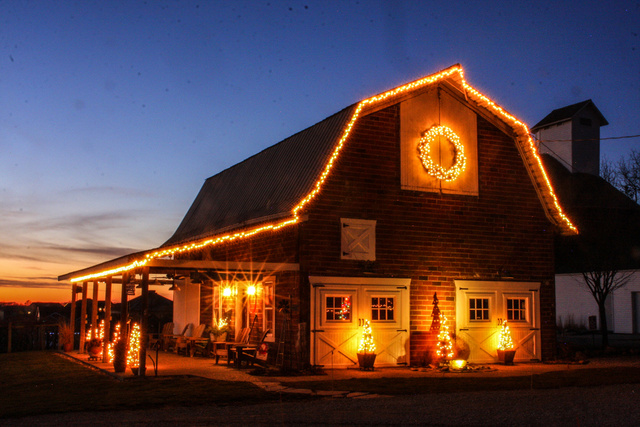
Adel Barn Accents Penoach Winery in Iowa
It started as a dairy barn in the 1920s on a farm north of Adel. By the mid-1990s, the farm was gone but the barn remained part of an acreage surrounded by new housing developments. In 2006, the barn became the hub of Penoach Winery and remains a big draw at this central Iowa destination.
“I like the fact that the barn is rustic and has lasted all these years,” said Joanie Olson, who runs Penoach Winery with her husband, Stan. “Our customers also love the old barn.”
The clay-tile barn was built on the H.B. Kinnick farm north of Adel to house dairy cattle. It was likely constructed with clay-tile blocks made in Adel. Olson recently met an 89-year-old gentleman from Arizona who is related to the Kinnick family and grew up on the farm.
“His father lost the farm during the Great Depression of the 1930s,” Olson said. “This man recalled sitting on the back porch and crying during the farm auction.”
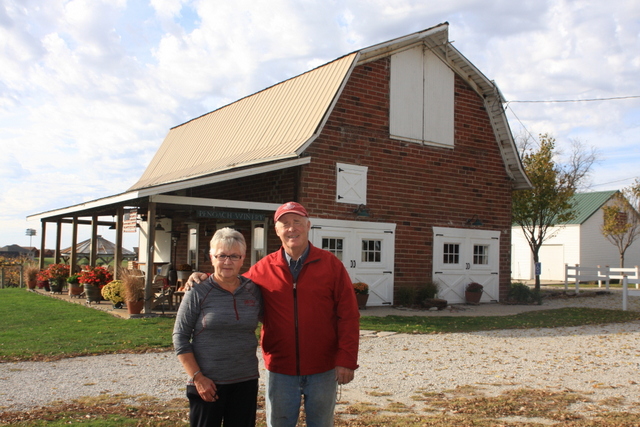
Stan Olson and his wife, Joanie, run Penoach Winery in this historic barn at their acreage north of Adel, Iowa.
In 1960, Olson’s parents, Paul and Mildred Hufferd, purchased the 240-acre farm, where they raised crops, cattle and hogs. Olson moved back to her family’s farm around 1980-81 with her husband, Stan, who had grown up on a farm near Lake Mills. The couple farmed for about 15 years. “My dad raised pigs in the barn, and then Stan did, too,” Olson said.
Although Stan began selling insurance after he quit farming, he never lost his passion for agriculture. “Stan missed growing things, so he planted 50 grape plants in 1999,” Olson said. In 2000, the Olsons started a grape nursery to supply grape vines to wineries that were taking root across Iowa.
Within a few years, the Olsons decided to start their own vineyard and winery. Penoach Winery, which reflects Adel’s original name, opened in 2006. Today, the operation includes 4 acres of grapes behind the barn, not far from areas once covered by cornfields and a hog lot.
“The barn was in pretty good shape when we started remodeling it for the winery,” Olson said. “We worked from top to bottom, starting with cleaning out the hay and pressure washing the barn.”
The transformation also included new floors, electrical wiring, plumbing, windows, doors and a covered patio on the south side of the barn. “Stan did most of the work,” Olson added.
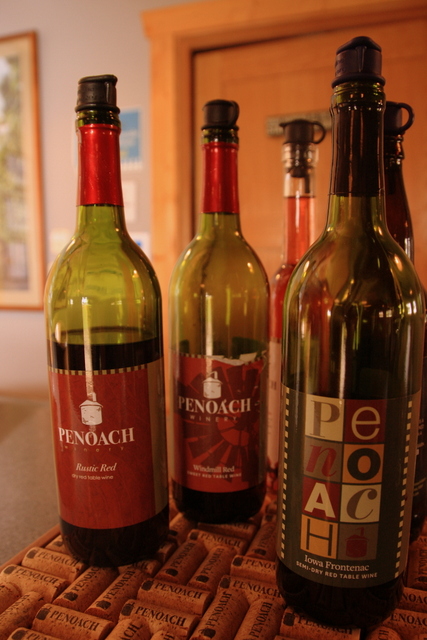
Penoach Winery offers a variety of Iowa wines produced from grapes grown on the Olson’s acreage north of Adel, Iowa.
While couple installed their wine-making equipment in the back of the barn, the space wasn’t quite large enough. About four years ago, the couple moved this equipment to a nearby shed and transformed the back room of the barn into a gathering space, complete with comfortable chairs. In the adjoining room, guests can browse the gift shop, which showcases 18 varieties of wine made at Penoach Winery.
“We enjoy meeting lots of people who visit our winery,” Olson said. “We’re glad we can share our barn with them.”
Want more Iowa culture and history? The barn at Penoach Winery will be featured in my upcoming book, Dallas County, a pictorial history from Arcadia Publishing, which will be released in the summer of 2017. In the meantime, check out my top-selling “Calhoun County” book, which showcases the history of small-town and rural Iowa, as well as my “Culinary History of Iowa” book from The History Press. Order your signed copy today!
P.S. Thanks for joining me. I’m glad you’re here.
@Copyright 2017 Darcy Maulsby & Co.
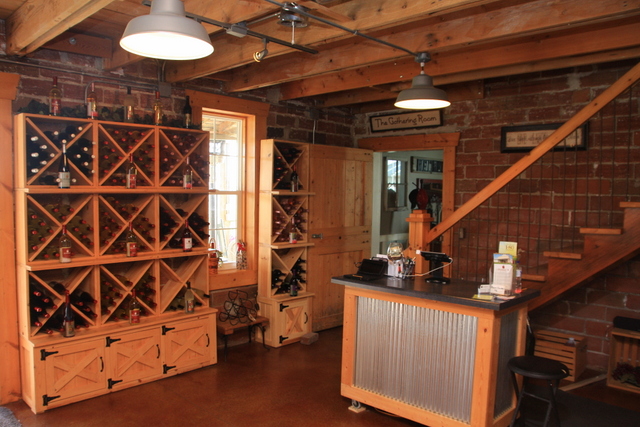
The interior of this former dairy barn is now an inviting, relaxing place to sample Iowa wines.
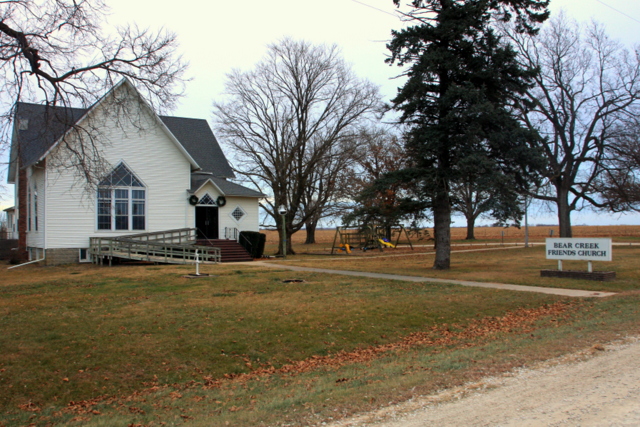
Slaves Escaped Through Dallas County on Iowa’s Underground Railroad
Imagine you’re a fugitive slave on the run in 1850s Iowa. You’ve managed to escape from Missouri and have made it all the way to Dallas County, but your owner and bounty hunters are close behind. If youor the people who are helping you escape on the Underground Railroad—get caught, the consequences are terrifying.
This really happened near the Quaker Divide northeast of Dexter, Iowa, around 160 years ago. It occurred after the federal Fugitive Slave Act of 1850 made it easier for southern slave owners to recovery their property and levied harsher punishments for anyone interfering in the capture of runaway slaves.
I’m going to include the story in my upcoming “Dallas County” book from Arcadia Publishing, which will be released in the summer of 2017. This will be my third book that helps bring Iowa history to life, along with Calhoun County and A Culinary History of Iowa.
Here’s a first-person look into the Underground Railroad in Iowa, as told by those who lived it. This excerpt comes from the “History of the Quaker Divide” by Darius B. Cook, published by the Dexter Sentinel, Dexter, Iowa, 1914. The story of the Underground Railroad documented here was written by Harmon Cook, who shared his personal experiences as one of its conductors:
Running away to freedom
In the days before the Civil War, Dallas County was on the frontier. Slavery was recognized as a product of Missouri. Iowa being a free state naturally proved a highway for the Underground Railroad. John Brown came through the area. The route started from Tabor in Fremont County and crossed diagonally Adair County, striking Summit Grove, where Stuart is now located.
“From there, one line went east down Quaker Divide, and the other crossed the Raccoon River near Redfield, then through Adel. Both lines came together at Des Moines, on to Grinnell to Muscatine and up to Canada. Many times I have seen colored men and women crossing the prairie…slaves running away to freedom.
In the winter of 1859-60, I was going to school to Darius Bowles, and one Friday evening I was told if I wanted to go to Bear Creek, I would not have to walk, if I wanted to drive a carriage and return it Monday morning. I drove the carriage, and in it were two young colored women. They were sisters and from the west border of Missouri. Their master was their father, and they had both been reared in the family.
War was apparent, and their master decided to sell them “down south.” They heard the plotting, and found out that they were to go on the auction block, and made a run for the North Star. They had been on the road seven weeks when they arrived at A.W.L’s at Summit Grove. Before daylight Saturday morning, they were housed at Uncle Martin’s.
You won’t find any slaves here
One Monday afternoon, one of the sisters, Maggie, who had been out in the yard came running in and told grandmother, “Master is coming up the road!” Grandfather went out in the front and sat down in his chair against the side of the door.
By this time, a number of men had ridden up and asked him if he had seen any slaves around. He told them slaves were not known in Iowa.
Then one of them said, “I am told that you are an old Quaker and have been suspected of harboring black folks as they run away to Canada. I have traced two girls across the country, and have reasons to believe they have been here.”
Grandfather said, “I never turn anyone away who wants lodging, but I keep no slaves.”
“Then I’ll come in and see,” said the man, who jumped off his horse and started for the house. Grandfather stood up with his cane in his hand and stepped into the door when the man attempted to enter. Grandfather said, “Has thee a warrant to search my house?”
“No, I have not,” replied the man.
“Then thee cannot do so,” Grandfather said.
“But I will show you,” said the man. “I will search for my girls.”
While this parley was going on, and loud words were coming thick and fast, Grandmother came up and said, “Father, if the man wants to look through the house, let him do so. Thee ought to know he won’t find any slaves here.”
Grandfather turned and started at her a minute, then turning to the men, said, “I ask thy forgiveness for speaking so harshly. Thee can go through the house, if Mother says so.”
Grandfather showed him through all the rooms but stayed close to him all the time. After satisfying himself that they were not there, he begged the old man’s forgiveness, mounted his horse and rode away.
When the coast was clear, it was found that when Maggie and rushed in and said, “Master is coming,” Grandmother hastily snatched off the large feather bed, telling both the girls to get in and lie perfectly still. She took the feather bed, spread it all over them, put on the covers and pillows, patted out the wrinkles—and so—no slaves were seen.
Almost caught
One time a big load was being taken down the south side of the Coon River and had reached the timber on the bluffs near Des Moines. About 3 o’clock in the morning as the carriage was leisurely going along, the sound of distant hoofbeats were heard coming behind. At first it was thought the carriage could outrun its pursuers, but prudence forbade.
A narrow road at one side was hastily followed a few rods, and the carriage stopped. The horseman passed on, swearing eternal vengeance on the whole “caboodle,” if captured. When sounds were lost in the distance, a dash was made for the depot in Des Moines, and all safely landed before daylight.
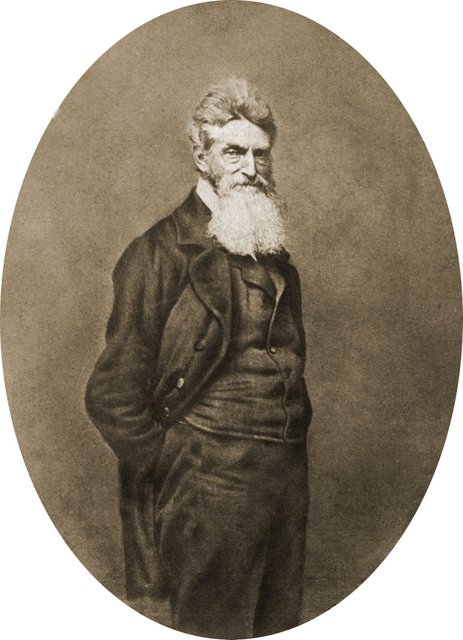
John Brown, abolitionist, aided the Underground Railroad in Dallas County, Iowa
John Brown came to Dallas County
One evening some months after I was returning from Adel on horseback and when opposite Mr. Murry’s farm east of Redfield when I saw Old Man Murry and a stranger back of the barn. I was met by an old man, rather stoop-shouldered and of stern aspect. “Mr. Murry said, “Here’s the youngster who came so near getting caught going to Des Moines.” The stern man with shaggy eyebrows almost in my face said, “Young man, when you are out on the Lord’s business, you must be more discreet. You must always listen backwards, as you are always followed. I’m responsible for that track of the Underground Railroad, and I want my conductors to be more careful in the future, as things are coming to a head, and somebody is going to get hurt.”
I was dismissed with this admonition: “Young man, never do so rash a thing again as to talk and laugh out loud on the way.” A few months later, when Harper’s Ferry was known to fame, I remembered John Brown as the old man at Murry’s.
Editor’s note: In 1859, John Brown led a small group of men who plotted to overthrow the institution of slavery by violent means, starting with a raid on the U.S. arsenal at Harper’s Ferry, West Virginia. Brown intended to incite a slave insurrection. Although he was suppressed by federal forces, Brown became a martyr in the eyes of the Abolitionist movement. Brown’s unsuccessful raid, along with the election of Abraham Lincoln in 1860, led Southern states to believe that they could never survive under an anti-slavery president. South Carolina led the Southern states in secession from the Union in December 1860, followed by Alabama, Mississippi, Georgia, Florida, Louisiana and Texas.
Reconnecting with a fugitive slave
Harmon Cook continued with his memories of the Underground Railroad in Dallas County:
When I enlisted in Company C, 46th Iowa Infantry, and arrived at Memphis, Tennessee, in 1864, I first saw a regiment of colored soldiers. They were in camp and the first opportunity I was over to see how they looked as soldiers. One of the camp scenes was some of the soldiers conducting a school to teach these poor people their ABCs.
Chaplain Ham and I had gone together, and the teacher, who was the lieutenant colonel, asked us to speak to the colored school. When I had spoken, a strapping fellow in blue uniform came rushing up to me, shouting, “I know you! You belong to the Quaker Divide in Iowa. You drove me one night when we were trying to get into town and were followed by our masters, and you drove off into the woods and we got out and hid.”
It was Henry who had been one of the party in that wild midnight ride. He never got to Canada, but stopped in Wisconsin, and when the war came on he enlisted. He was lieutenant of the colored regiment and was a trusted scout for the general of our division.”
Background notes on the Underground Railroad in Dallas County
The Bear Creek Settlement, also known as the “Quaker divide” in southern Dallas County north of Dexter, is located between the South Raccoon River on the north and Bear Creek on the south.
In the early 1850s this area was open prairie without a single settler. But a Quaker family (including Richard Mendenhall and his wife, Elizabeth) from Marion County, Indiana, settled in Dallas County in 1853 in Union Township in what would become the Quaker Divide.
While the Quakers were among the most prominent slave traders during the early days of America, paradoxically, they were also among the first religious denominations to protest slavery. While not all Quakers participated in the organized anti-slavery movement, many did—including many in Iowa.
Traces of the Underground Railroad remain in Iowa—see for yourself
There are remarkable places across Iowa where you can see the few remaining stops on the Underground Railroad that are still standing and open to the public. I’ve toured many of these remarkable sites, and they are well worth a road trip. Click here to get more details on the Hitchcock House in Lewis, the Jordan House in West Des Moines and the Lewelling House in Salem and more. I encourage you to visit these Underground Railroad sites and reconnect with this powerful chapter of Iowa history.
Want more Iowa culture and history? Check out my top-selling “Calhoun County” book, which showcases the history of small-town and rural Iowa, as well as my “Culinary History of Iowa” book from The History Press. Order your signed copy today!
P.S. Thanks for joining me. I’m glad you’re here.
@Copyright 2017 Darcy Maulsby & Co.

All Aboard! Rockwell City’s “Depot People” Offer a Taste of Iowa History
Eating like a hobo never tasted so good, at least when the “Depot People” are cooking. The savory aromas that emanate from the historic railroad depot in Rockwell City for one afternoon each fall signal that something good is coming down the line.
“I love this little museum and enjoy giving people a taste of the past,” said Carol Hupton of Rockwell City, president of the board of “Depot People” who have transformed the 1899 depot and freight shed into a museum.
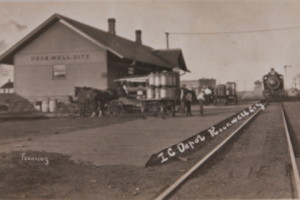
A train rolls into the Illinois Central Railroad depot in Rockwell City years ago.
During the annual fundraiser, which Hupton has helped with for the past six years, home cooking offers a feast at the Rockwell City depot a block north of the Calhoun County courthouse. Guests can dine on homemade hobo stew, hot dogs, homemade cookies, bars and more, with all proceeds going to restoration projects at the depot.
Saving the depot has been a labor of love for the Depot People, a group of about 25 people who want to preserve their community’s history. “There was a time when the depot was in danger of being torn down,” said Hupton, who has been volunteering with the depot museum for 10 years. “People don’t always realize the important role the railroad played to help Iowa and small towns like Rockwell City grow.”
The first railroad to arrive in Rockwell City was the Des Moines & Northern line, which was later taken over by the Chicago, Milwaukee & St. Paul Railway. The first passenger train rolled into town in 1881.
Rockwell City’s second railroad was the Illinois Central. Surveying the land between Fort Dodge and Rockwell City for this rail line began in 1899. Around 1903, the Newton and Northwestern Line, an interurban line, became the third rail line to Rockwell City. For decades, it brought passenger cars from Newton and Des Moines every two hours from 7 a.m. to 9 p.m.
During the heyday of the railroad, Rockwell City became a stop for multiple passenger trains and freight trains each day. Weary travelers could enjoy a meal at the nearby Hotel Brower or various restaurants in town.
In time, paved roads and interstate highways led to increased traffic from cars, pickup trucks and semi-trucks across Iowa and the nation, marking the end of an era for passenger trains. Railroad transportation itself changed as powerful diesel engines replaced the steam engines that once powered the many trains that rolled across the Iowa countryside. “Now the old depot here in town stands alone as a reminder of our history with the railroads,” Hupton said.
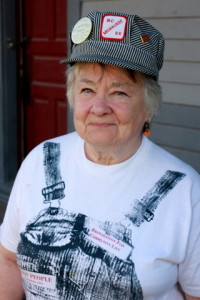 Sharing this history is important to Hupton and her fellow volunteers. The depot’s fundraising meal offers another way to encourage people of all ages to visit the museum. “Many kids don’t know anything about the history of the railroad in Rockwell City or other small Iowa towns,” Hupton said.
Sharing this history is important to Hupton and her fellow volunteers. The depot’s fundraising meal offers another way to encourage people of all ages to visit the museum. “Many kids don’t know anything about the history of the railroad in Rockwell City or other small Iowa towns,” Hupton said.
That’s why the Depot People have created historical exhibits in the depot, including vintage photos of the depot, to show the important role it once played in the community. A recreated hobo camp east of the freight shed also helps visitors learn how the railroad influenced people’s daily life in various ways.
The Depot People continue to apply for grants and host fundraisers with meals to preserve local railroad history. A summer car show allows car, truck and motorcycle fans to display their prized vehicles, while guests can dine on pulled pork sandwiches, potato chips, homemade desserts.
In the fall, the depot becomes an informal dining room where guests can enjoy a hearty bowl of homemade hobo stew, sugar cookies, salted nut roll bars and other goodies prepared by some of Rockwell City’s best cooks and depot supporters, including Maurine Zuetlau.
“Rockwell City’s depot is a landmark,” Hupton said. “We’ll continue to do what we can to preserve this local history.”
Savor more Iowa food history
Want more fun Iowa food stories and recipes? Check out my top-selling “Culinary History of Iowa” book from The History Press, and order your signed copy today.
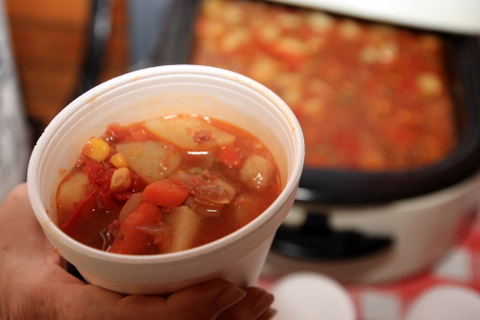
Hearty Hobo Stew from Iowa
Hearty Hobo Stew
4 pounds rump roast, cut up into cubes
Olive oil
2 cups diced celery
1 1 / 2 cups carrots, sliced
2 cups apple-cider vinegar
2 cups French onion condensed soup
3 to 4 cups potatoes, cubed and cooked
2 cans diced tomatoes
Beef stock (use as much as desired for the right consistency of stew)
Corn kernels, optional
Peas, optional
Brown the cubes of beef in olive oil. Combine beef with remaining ingredients. Place stew in roaster and cook until heated through.
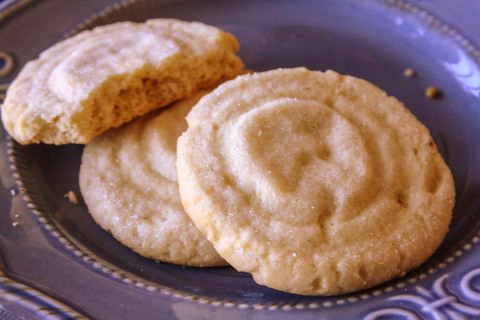
Homemade Sugar Cookies
World’s Best Sugar Cookies
These Amish sugar cookies come from Maurine Zuetlau of Rockwell City.
1 cup powdered sugar
1 cup granulated sugar
1 cup butter (can use half butter and half margarine)
1 cup vegetable oil
2 eggs
2 teaspoons vanilla
1 teaspoon salt
1 teaspoon cream of tartar
1 teaspoon baking soda
5 cups flour
Mix all ingredients. Roll dough into balls to form each cookie. Roll each dough ball in granulated sugar. Press down each ball with a glass dipped into granulated sugar. Bake cookies at 350 degrees for 13 to 15 minutes. Let cool on cookie sheet 2 to 3 minutes. Remove cookies and place on cooling rack.
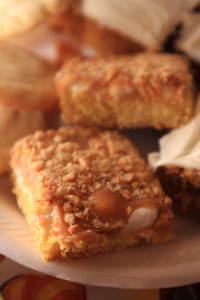
Salted Nut Roll Bars
Salted Nut Roll Bars
These tasty bars are reminiscent of salted nut roll candy bars and come from Maurine Zuetlau of Rockwell City.
1 package yellow cake mix
1 / 2 cup softened margarine
1 egg
3 cups mini marshmallows
2 / 3 cup white corn syrup
1 / 4 cup margarine
1 12-ounce package peanut butter chips
1 cup chopped, dry-roasted peanuts
Combine cake mix, 1 / 2 cup margarine and egg. Pat mixture into 9-inch by 13-inch pan. Bake at 350 degrees for 18 to 20 minutes. Cover bars with marshmallows. Return to oven for 2 to 3 minutes. (Marshmallows will puff up.) Cool.
Boil white corn syrup and 1 / 4 cup margarine. Remove from heat. Add peanut butter chips. Pour mixture over marshmallows and top with nuts. Cool completely, cut into bars.
P.S. Thanks for joining me. I’m glad you’re here.
@Copyright 2016 Darcy Maulsby & Co.
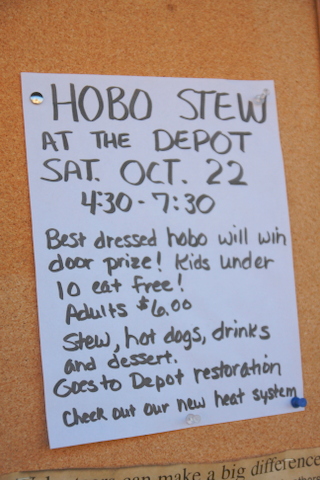
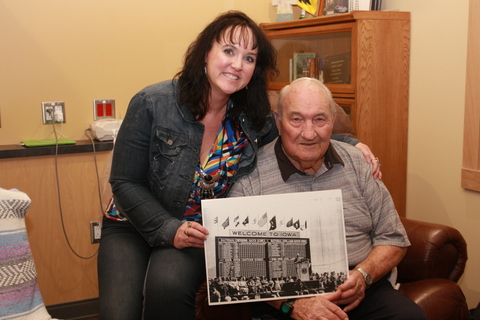
Riding with Harry: 2016 Presidential Election Reflects Truman’s Iowa Revival at 1948 Plowing Match in Dexter
Unpredictable. Shocking. Historic. All have been used to describe the 2016 presidential election, but they also characterized the remarkable presidential election of 1948. Back then, no one thought Harry Truman had any chance of returning to the White House, although he accomplished one of the biggest upsets in U.S. presidential history—and it all started on a farm near Dexter, Iowa.
Bob Larson, an 18-year-old farm boy from Casey, saw it all. “Harry Truman was a farmer, not a politician, at heart,” said Larson, 86, who met Truman on September 18, 1948, at the National Soil Conservation Field Days and Plowing Matches in Dallas County. “We can thank him for the conservation practices that are now common in agriculture.”
A recent high school graduate, Larson was working construction in 1948 with his future father-in-law. The crew was recruited to help build a dam and pond in the conservation demonstration fields north of Dexter. Larson first saw Truman on the afternoon of September 18, when the president jumped off a hayrack at the national plowing matches and headed toward the conservation area. Truman visited with Larson and his friends and family, who were eating lunch under a shade tree.
“Truman said, ‘What the hell are you doin’ just sitting here? Get your dozers started and get back to work. I want to watch you,’” said Larson, who noted that the construction crews had been told to shut down their machines when the president was in the area. “Truman rode with me on my bulldozer for about 10 minutes.”
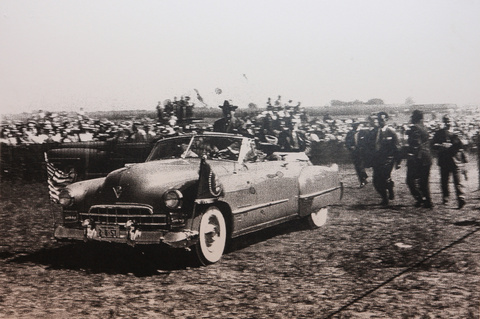
WhenTruman arrived in Dexter on Sept. 18, 1948, he was a 50-to-1 underdog against his presidential rival, New York Governor Thomas Dewey. Nevertheless, a crowd welcomed Truman to Dexter, Iowa, in grand style. As part of his whistle-stop presidential campaign, Truman arrived in Dexter via the Rock Island Railroad, where he was greeted at the depot by the Dexter school band, a parade and a queen and her court. The president, his wife, Bess, and their daughter, Margaret, were escorted to the farm site north of Dexter by a motorcade that included Truman’s convertible limousine.
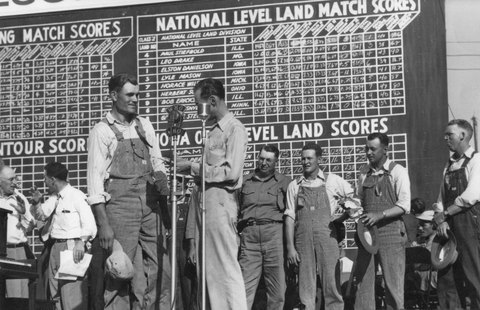
Donald Hanson (left of the radio microphone), a farmer from Roland and competitor at the 1948 National Plowing Matches near Dexter, Iowa, was interviewed on WHO Radio. Hanson is the grandfather of Eric Hanson, a television reporter and anchor on KCCI in Des Moines.
Truman came to Iowa to “Give ‘em Hell”
When Truman arrived in Dexter on Sept. 18, 1948, he was a 50-to-1 underdog against his presidential rival, New York Governor Thomas Dewey. Truman’s appearance in Dallas County stemmed from a White House visit months before when Iowa Farm Bureau President E. Howard Hill and other Iowa ag leaders met with Truman in May 1948 and invited him to come to the National Soil Conservation Field Days and Plowing Matches. The president tried to discourage the men, asserting that they’d have nothing but problems if he and his entourage came.
Dewey was also invited to attend the event but turned the Iowans down flat. “Dewey thought he had the election locked up,” Larson said. “The Midwest didn’t like Dewey, because he was an elitist who had no time for Iowa dirt farmers.”
Months went by with no word from the White House. Then three weeks before the big day, plowing match organizers were notified that Truman had accepted their invitation. Once Dewey heard Truman was headed to Iowa, he immediately arranged for a farm-press event to be held on his Pawling, N.Y., farm on the same day as the national plowing matches near Dexter.
While the media focused on New York, all roads led to the nation’s largest farm event in central Iowa on the September 18, 1948. As the sun rose and the mercury soared, bumper-to-bumper traffic soon clogged the roads near Dexter.
The crowd welcomed Truman in grand style. As part of his whistle-stop presidential campaign, Truman arrived in Dexter via the Rock Island Railroad, where he was greeted at the depot by the Dexter school band, a parade and a queen and her court. The president, his wife, Bess, and their daughter, Margaret, were escorted to the farm site north of Dexter by a motorcade that included Truman’s convertible limousine.
Much to Truman’s delight, a huge crowd of 100,000 people gathered on Lois Agg’s farm to watch the plowing matches, see new conservation practices in action and hear him deliver a speech about farm policy.
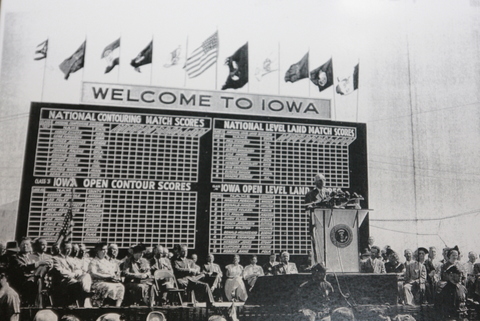
President Harry Truman spoke about farm policy before a crowd of 100,000 people on Sept. 18, 1948, near Dexter, Iowa. This was the first speech that was referred to as “Give ‘Em Hell, Harry,” a slogan that stuck with Truman for the rest of the campaign.
WHO Radio personality Herb Plambeck introduced Truman. During Truman’s 29-minute speech, which was the first major speech of his 1948 presidential campaign, he was interrupted by applause 13 times. The loudest cheers came when he referred to the 80th Congress as the “do nothing Congress.” This was the first speech that was referred to as “Give ‘Em Hell, Harry,” a slogan that stuck with Truman for the rest of the campaign.
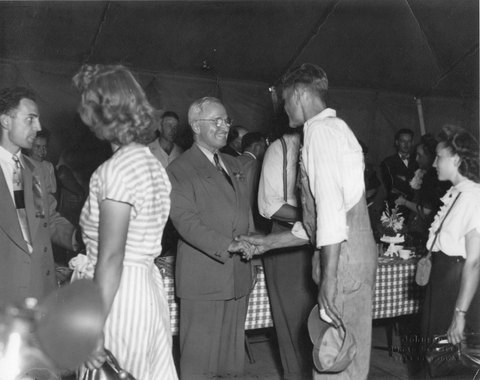
President Harry Truman greeted the crowd at the 1948 National Soil Conservation Field Days and Plowing Matches in Dallas County.
Event ushered in the modern era of ag conservation
After the speech, Truman and his entourage dined on fried chicken before heading out to the demonstration sites to see terraces, ponds and other conservation practices. Truman jumped off the hayrack to get a closer look, as members of the Secret Service scrambled to catch up with him.
“Truman was very interested in soil conservation and asked us a lot of questions,” Larson said. “While some guys thought terraces and contour farming were crazy, many farmers were intrigued by new conservation practices that were being promoted by the Soil Conservation Service.”
Truman took off his suit jacket, rolled up his sleeves on that hot afternoon and continued asking questions as he rode on Larson’s bulldozer while the Secret Service looked on. Larson wasn’t nervous as he chauffeured the president. “Truman was just an old farmer who wanted to know practical things, like how much dirt I was hauling.”
The response Truman received in Dexter that day revitalized his presidential campaign and Truman himself. While the polls still had Truman trailing Dewey on the eve of the 1948 election, and his margin of victory was small, Truman went on to become the 33rd president of the United States.
Truman’s appearance at Dexter also helped usher in the modern era of conservation in agriculture. Larson’s conservation work left a lasting impact, as well, since the dam and pond he built in 1948 are still there. His story, along with photos from that unforgettable day, are preserved at the Dexter Museum and on a historical marker north of Dexter.
“Truman made a good impression on me,” Larson said. “If I’d been old enough to vote in 1948, I probably would have picked Truman.”
Explore more rural Iowa history
Want to discover more stories and pictures that showcase the unique history of small-town and rural Iowa? Check out my top-selling “Calhoun County” book from Arcadia Publishing, and order your signed copy today.
P.S. Thanks for joining me. I’m glad you’re here.
@Copyright 2016 Darcy Maulsby & Co.
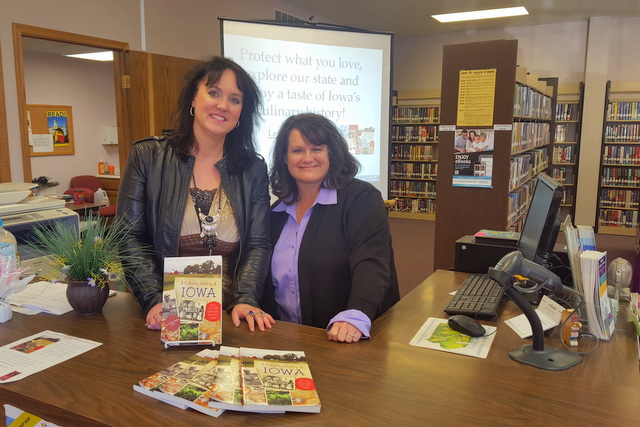
Iowa Eats! Why Radio Iowa, Newspapers and Libraries are Hungry for “A Culinary History of Iowa”
Everyone has an Iowa food story, even those doubters who sounded incredulous when I first proposed my idea for my “Culinary History of Iowa” book. Their amusement, followed by the inevitable question, “Iowa has a culinary history?” quickly dissolved into stories of Maid-Rites, potlucks and more.
The media, Iowa libraries and others across the state have really embraced these stories, too. I was honored to offer book programs and signings at the Ruthven Public Library and beautiful Kendall Young Public Library in Webster City. I was also pleased that the Webster City Freeman Journal ran a feature story on my book, at Pat Powers from KQWC Radio in Webster City interviewed me in a broadcast that has now popped up on Radio Iowa.
Need a fun read or a great gift idea? Click here to visit my online store, where you can purchase copies of “A Culinary History of Iowa,” a unique set of 15 vintage images from “A Culinary History of Iowa,” and my first book, “Calhoun County,” which shares the remarkable, illustrated history of small-town and rural Iowa through the eyes of those who lived it.
November 19th, 2016 by Ric Hanson
http://www.kjan.com/index.php?cat=3&paged=2
From pork tenderloins to sweet corn to Jell-o, a new book is out focused on Iowa foods and the flavors that make the state so delicious. The book, “A Culinary History of Iowa,” traces the popular tastes of Iowans through the years, according to author Darcy Dougherty Maulsby, of Lake City. “We do have great cuisine,” Maulsby says. “It’s funny. When the book came out, I had some people questioning, ‘Iowa has a culinary history?’ We sure do. I said, ‘Just starting thinking what defines Iowa food,’ and everybody always comes up with an answer.” Maulsby says she’s done research for the book by exploring all four corners of the state and everything in between.
“I’ve been working on it in bits and pieces for almost 20 years in my career as an ag journalist,” Maulsby says. “I’ve traveled the state and met with some of Iowa’s finest chefs and lots of great old-school farm cooks. I’ve seen the spectrum of really awesome Iowa food and it’s been so much fun to collect all of these stories and photos in one place.” Some might categorize it as a cook book but Maulsby says it’s more than that.
“It’s the story behind the things that define Iowa food,” Maulsby says. “Whether that’s Maid-Rites, Dutch letters from Pella, there’s so many fun stories, Laura Ingalls Wilder turns up in there, the Younkers Tea Room, all of these amazing traditions, meat lockers, sweet corn, all of the things that make Iowa food great.” Find the book at the Amazon and Barnes & Noble websites as well as at: www.darcymaulsby.com. (Radio Iowa)
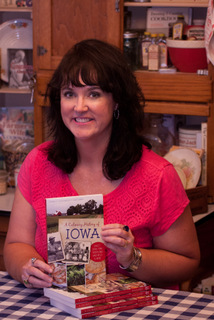
Darcy Maulsby is the author of “A Culinary History of Iowa,” which serves up stories, photos, recipes and more!
Iowa Eats: Maulsby pens book on the state’s culinary history
NOV 16, 2016
by ADRI SIETSTRA, Webster City Freeman Journal reporter
asietstra@freemanjournal.net
Author Darcy Maulsby will be bringing Iowa food stories to life during a free program Thursday evening at 6:30 p.m. at Kendall Young Library. The program will feature a cooking demonstration with book signing to follow.
“You’ll love this fun, fast-paced program filled with stories, rare vintage photos and surprising recipe tips. Be prepared to dig into the remarkable stories behind Iowa classics like Maid-Rites, breaded pork tenderloins, Iowans’ obsession with Jell-O, and our distinctive chili-and-cinnamon roll phenomenon,”said Maulsby. “I’ll also share practical, proven tips on how to preserve your own family’s history and food traditions.”
Maulsby, 43, is a self-described foodie and home cooking enthusiast from Lake City. She began baking and cooking in grade school while growing up on the farm. She entered many cooking contests at the Calhoun County Expo while a member of the Lake Creek Go-Getters 4-H Club.
“Food writing is a large part of my work as a small-business owner, freelance writer and marketing specialist who focuses on agriculture. I work with clients ranging from the National Pork Board to Farm News, where I often interview chefs and home cooks, create recipe pages and write feature stories that highlight the farm-to-fork connection,” said Maulsby.
In 2007, Maulsby completed the Master Food Preserver course through University of Illinois Extension. She earned her bachelor’s degree in journalism/mass communications and history from Iowa State University (ISU) and also earned her master’s degree in business administration from ISU.
Maulsby’s jams have won blue ribbons at the Iowa State Fair, and cookies have earned top honors at the Clay County Fair. She is also a certified Kansas City Barbecue Society judge.
Maulsby credits a variety of sources for the inspiration for her new book.
“The stories in “A Culinary History of Iowa” have come from the Iowa State Fair, as well as long-time restaurant owners, experienced farm cooks, candy shop owners and other foodies throughout Iowa,”Maulsby said.
Maulsby is excited to share some of Iowa’s culinary history with attendees Thursday evening.
“Everyone has a food story. Sometimes we don’t realize just how unique-and tantalizing-Iowa’s food traditions are. If you like to travel, you’ll walk away from this program inspired to explore Iowa, where you can sample flavors from around the globe without leaving the state,” said Maulsby. “If you have an appetite for adventure, you can’t do better than Iowa when it comes to history, agriculture and one-of-kind culinary experiences.”
Signed copies of her book “A Culinary History of Iowa” will be available for $24 a copy.
Celebrating great Iowa eats
LINDSAY ANDERSON, Kendall Young Librarian
 We Midwesterners are known far and wide for our excellent, down-home cuisine. Having only lived in Iowa for two years, I have already eaten enough to be amazed at Iowa’s particular brand of culinary delights.
We Midwesterners are known far and wide for our excellent, down-home cuisine. Having only lived in Iowa for two years, I have already eaten enough to be amazed at Iowa’s particular brand of culinary delights.
Have you ever wondered why Iowans cook – and eat – so well, and from where your signature recipes and food traditions originate? Iowa author and Lake City native, Darcy Maulsby, explores these and other food stories in her recently published book, Culinary History of Iowa. In it, she discusses everything from Maid-Rite classics to Iowan’s homemade cinnamon rolls (served with chili, of course). The Library is delighted to be hosting Maulsby at Kendall Young Library on Thursday, November 17 at 6:30pm for a presentation, book signing and cooking demonstration. Maulsby has been featured in the Iowa History Journal, Our Iowa magazine, Iowa Public Radio, and more. During Maulsby’s fun, interactive program, she will serve up fascinating tidbits related to more than 150 years of Iowa cuisine from all corners of the state. Attend this free event and discover how Iowa’s delectable cuisine is quintessentially Midwestern, grounded in its rich farming heritage and spiced with diverse ethnic influences.
On the Shelf
If all this talk of food has left you hungry, here are some titles that can help get some great, local Iowa eats cooking in your kitchen: The following cookbooks were recently added to the Library’s Genealogy Reference collection. While we do not allow these unique cookbooks to be checked out, you are welcome to browse them and make copies of any recipes that catch your eye.
The Famous Old Webster City Cook Book
Curated by The Ladies’ Aid Society of the Congregational Church in 1916, this cookbook boasts only “tried and tested” local recipes, including everything from waffles and pancakes, to salads and corn breads. A fun addition: the past page of this cookbook includes “Discoveries and Household Hints,” a delightful list of tips and tricks from some early 1900s kitchen experts.
4-H & Friends Cookbook
Assembled in honor of the Hamilton County 4-H program’s 70th anniversary in 1987, this nearly 400-page volume is painstakingly indexed, and boasts over 13 sections of recipes. Explore and discover some delightful gems; experiment with recipe choices ranging from “Shoo-Fly Cake” to “Gramma’s Hamburger Soup”.
St. Paul’s Lutheran Church Anniversary Cookbook
Compiled by the ALCW of St. Paul’s Lutheran Church of Williams, Iowa in 1987 to commemorate their 75th anniversary, this volume boasts more than 250 pages of hardy, time-tested eats that will satisfy your hunger and delight your taste buds. Try your hand at everything from “Buttermilk Cinnamon Bars,” to “Zucchini Date Pecan Loaf,” to “Highbrow Haddock.”
Try out these locally celebrated recipes for some delicious mealtime fun, and don’t forget to join us at the Library with Darcy Maulsby on Thursday, November 17 at 6:30pm for an unforgettable (not to mention delicious) journey into Iowa’s culinary past.
Order you copies today!
Click here to visit my online store, where you can purchase copies of “A Culinary History of Iowa,” a unique set of 15 vintage images from “A Culinary History of Iowa,” and my first book, “Calhoun County,” which shares the remarkable, illustrated history of small-town and rural Iowa through the eyes of those who lived it.
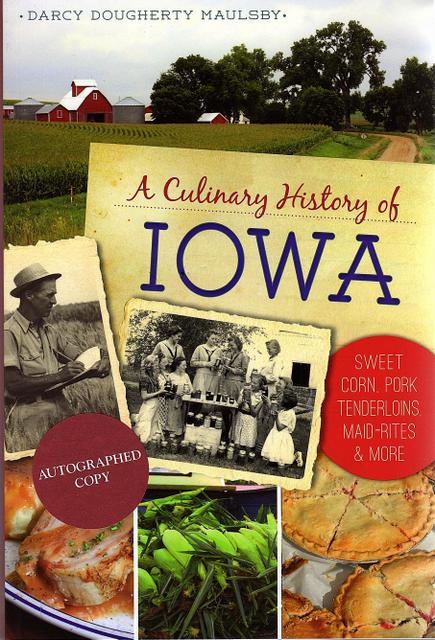
Talking Iowa Food and Culinary History on Iowa Public Radio
What do you think of when you think of Iowa food? Charity Nebbe explored Iowa’s amazing culinary history with me during “Talk of Iowa” on Iowa Public Radio recently, and you won’t believe all the incredible stories we covered in 20 minutes!
Listen to the complete “Talk of Iowa” interview about “A Culinary History of Iowa here.
Want to learn more about the book or its companion postcard packet of 15 vintage Iowa culinary history images? Check out my online store!


“A Culinary History of Iowa” Satisfies: Iowa History Journal Book Review
This terrific review of my latest book, “A Culinary History of Iowa: Sweet Corn, Pork Tenderloins, Maid-Rites and More,” from The History Press appeared in the September/October issue of Iowa History Journal. Enjoy!
Also, if you’d like to get your own signed copy of “A Culinary History of Iowa” or would like to send signed copies as gifts, click here to visit my online store. I appreciate your support for authors and Iowa-based small business!
Iowa has a long and substantial culinary history; far deeper than corn and pigs that are so often associated with our farm-rich state. “A Culinary History of Iowa,” written by Darcy Dougherty Maulsby, delves deep into its past, tracing as far back as the pioneer settlers for the story of food in Iowa.
From well-known names such as the Graziano Brothers, Blue Bunny ice cream and Maytag Blue Cheese, to hidden gems found in the most unexpected places, Iowa’s food culture is incredibly varied. As the book’s subtitle “Sweet Corn, Pork Tenderloins, Maid-Rites and More” suggests, there are unique flavors to be discovered across the state.
The book is an excellent primer on the roots of Iowa farmland, as well as current trends. Beginning with an overview of Iowa’s agricultural value and its products from American Indian traditions through the Great Depression and beyond, Maulsby concisely writes how Iowa history is tied to food creation, proliferation and consumption. The Iowa State Fair is a section unto itself, which befits the food-centric and beloved affair. A diverse gallery of local events (country fairs, sweet corn festivals) and modern confabs (Baconfest) are the beneficiaries of profiles, as well.
Finally, the book devotes space to the many long-established restaurants that can be found almost anywhere in Iowa; each with its own story to tell. It’s always fascinating to see history through a different lens, and Iowa’s culinary exploits definitely shine throughout these pages.
 Iowa has been influenced by many cultures in a variety of ways, but nowhere does that cultural melting pot shine so bright as in the kitchen. Polish, Swedish, German, Dutch and other culinary traditions are highlighted across multiple chapters in an exploration of what it means to be an immigrant in Iowa and how such cultures blend to create a far more ethnically diverse cuisine than many realize. Of all the observations and stories in the book, these wonderfully inclusive stories are among my favorites.
Iowa has been influenced by many cultures in a variety of ways, but nowhere does that cultural melting pot shine so bright as in the kitchen. Polish, Swedish, German, Dutch and other culinary traditions are highlighted across multiple chapters in an exploration of what it means to be an immigrant in Iowa and how such cultures blend to create a far more ethnically diverse cuisine than many realize. Of all the observations and stories in the book, these wonderfully inclusive stories are among my favorites.
This eclectic mixture of historical tidbits, social observations, vintage photos and delicious recipes provides just the right ingredients for a delightful reading experience. Maulsby, an Iowa native and lifelong food lover, has an obvious passion for her topic, and it pays off in this compact and charming book. She has worked across the state and Midwest for such diverse entities as Progressive Farmer magazine and the Iowa Turkey Federation.
Maulsby has written in many publications about Iowa food, and it’s clear that it is a labor of love and a collaborative labor as Maulsby solicited tales input from all across the state for the juiciest food-related tales and locations. Even those who are well acquainted with Iowa food lore are sure to find something new and interesting.
Ideal for anyone with a love of food history and particularly those with a Midwestern heart, this book has so many interesting tales, morsels of trivia and personal anecdotes that it feels as though the book should be twice as long. Go on an adventure with this fun, fascinating and tasty tale of culinary traditions that weave through Iowa’s past and present. Just be sure you have a snack handy.
(Julie Goodrich is a graduate of the University of Iowa and the University of Wisconsin. She works at Beaverdale Books in Des Moines, in addition to holding down a full-time job because she loves books.)
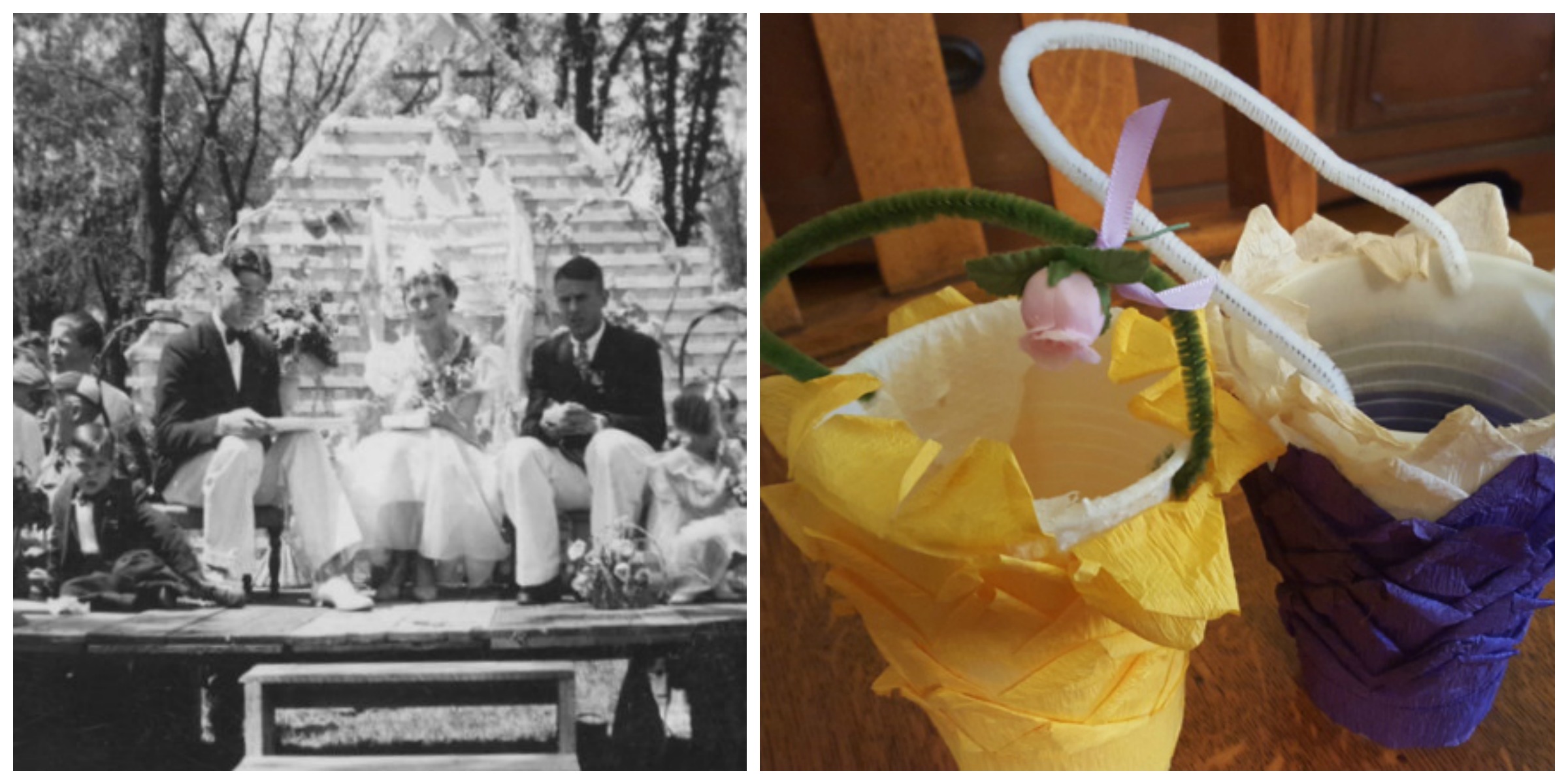
Mayday, Mayday—The Lost History of May Poles and May Baskets in Iowa
Remember the fun, colorful tradition of creating homemade May baskets? (I do.) If you’re a certain age, you may even remember dancing around the May pole. (I don’t). All were once beloved rites of spring here in Iowa and across America.
In many Midwestern communities, May Day celebrations were a highlight of the year. As I researched my book “Calhoun County,” which showcases the history of small-town and rural Iowa through the eyes of those who lived it, I came across a unique picture. Thelma Basler, a member of the senior class of 1935, was elected May Queen by the Lohrville High School student body. In addition to voting for the May Queen
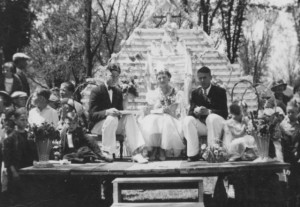
Lohrville High School May Queen, Thelma Basler, 1930s, Lohrville, Iowa
, students decorated the school flagpole in honor of May Day and delivered May baskets to friends.
While these May 1 customs have largely faded from American pop culture, they still endure in pockets of Iowa and beyond, where some of my friends’ children still enjoy making May baskets filled with treats. I started thinking—where did these May Day traditions come from? A little research hinted at something less wholesome than childhood craft projects and school celebrations.
Taming a raucous rite of spring
May pole dancing, for example, dates back to ancient pagan cultures in Europe. Each spring, people would erect a May pole, often of cedar or birch, and dance around it, typically weaving colorful ribbons around the pole as they went, to ensure a fruitful planting season.
An obvious phallic symbol, a May pole was strongly associated with fertility. After the European continent became Christianized, the more raucous elements of May Day celebrations were toned down, but the May pole dance and May baskets survived in a more G-rated form. These customs were carried to America, where they endured well into the twentieth century.
May Day memories from small-town Iowa
In my home town of Lake City, Iowa, Jolene Schleisman recalls weaving ribbons around a May pole in the gymnasium/lunchroom at Lincoln Elementary School in the 1960s. This spring ritual had ended by the time I attended Lincoln Elementary in the 1980s, although I did take square-dancing lessons in
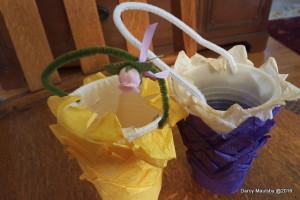
Homemade May baskets created in Lake City, Iowa
music class, a tradition that has now gone the way of the May pole.
During my time at Lincoln Elementary, I did get to experience the joy of making May baskets filled with candies and popcorn to give to friends and family. In the 2015 article “A Forgotten Tradition: May Basket Day,” NPR explained the phenomenon this way:
“As the month of April rolled to an end, people would begin gathering flowers and candies and other goodies to put in May baskets to hang on the doors of friends, neighbors and loved ones on May 1. In some communities, hanging a May basket on someone’s door was a chance to express romantic interest. If a basket-hanger was espied by the recipient, the recipient would give chase and try to steal a kiss from the basket-hanger.”
In Lake City, homemade May baskets became a fundraiser for the ladies of the Presbyterian Church in the mid-twentieth century. Church members including Fanny Howell, principal of Lake City High School from 1928 to 1935, made May baskets out of small paper milk cartons (washed and sanitized with bleach). The ladies decorated each May basket with colorful crepe paper and attached pipe cleaners for handles.
The cheerful baskets were displayed in the front window of McIntyre Furniture store on Center Street, where the smaller baskets could be purchased for a penny apiece. Buyers could then fill the baskets with the treats of their choice and deliver them to friends around town.
Long gone are the penny May baskets, McIntyre Furniture, Fanny Howell and many of the traditions that once defined May 1 in communities across Iowa and beyond. In one respect, however, I’m glad that some major company has not rediscovered May Day, only to mar its simplicity with commercial baskets, cards and trinkets. There’s still something to be said for simplicity and tradition.
Savor more Iowa food history
Want more fun Iowa food stories and recipes? Sign up today for my blog updates and free e-newsletter, or click on the “Subscribe to newsletter” button at the top of my blog homepage.
Check out my top-selling “Culinary History of Iowa” book from The History Press, and order your signed copy today. You can also order my “Calhoun County” Iowa history book, postcards made from my favorite photos of rural Iowa and more at my online store. Thanks for visiting!


